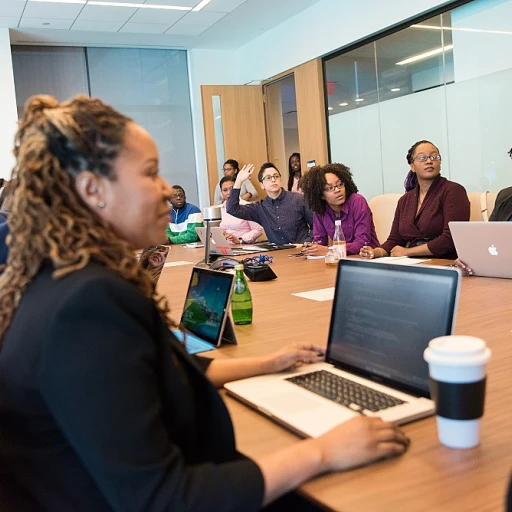Understanding the Importance of Employee Retention in Collections
The Role of Employee Retention in Collections Department Success
In the field of collections, maintaining a stable workforce is not just beneficial—it's crucial to the overall success of the department. Effective employee retention strategies are essential to preserving the knowledge and skills within your team, consequently minimizing turnover rates. A high turnover not only disrupts the workflow but also incurs significant costs in terms of recruiting and training new team members.
Ensuring employee satisfaction and engagement is paramount to reducing turnover. When employees feel valued and supported, they are more likely to stay committed to their job in the long term. This commitment is often a direct reflection of the company culture and work environment offered by the organization. A positive work environment fosters a sense of belonging and purpose among employees, which can significantly boost retention rates.
Many organizations recognize that the debt collection industry demands specific retention strategies due to its unique challenges. Creating opportunities for career development and offering competitive pay and benefits are seen as best practices in boosting employee engagement and motivation. Moreover, implementing flexible work options can go a long way toward making employees feel appreciated, thereby enhancing employee retention.
As companies aim to hold onto their top talent, they often focus on building strong team dynamics and culture. By investing time and resources into understanding what drives employee satisfaction, organizations can tailor their retention strategies to meet their team's specific needs. This focus not only enhances the overall employee experience but also strengthens the organization's reputation within the industry.
Identifying Key Challenges in Retaining Collections Employees
Confronting the Unique Hurdles
In sectors like collections, maintaining a steady workforce is essential for the achievement of business objectives. Recognizing the distinctive challenges in this industry equips organizations to bolster their employee retention strategies more effectively. Collections departments are often marked by a demanding pace and high-pressure environments, contributing to elevated turnover rates. Employees regularly handle complex situations, affecting their morale and long-term job satisfaction. Therefore, in understanding these challenges, organizations can develop more honed retention strategies that accommodate these unique work conditions. Furthermore, the competitive nature of the industry means retaining top talent is closely linked to providing a work environment where employees feel part of a supportive team. This can hinge significantly on company culture and how well it aligns with the values of the employees. Ensuring that these elements are aligned is crucial in fostering an environment where employees thrive. Team dynamics also play a crucial role. For collections departments, where teamwork is vital to manage workloads effectively, creating an inclusive and positive work culture is key. This encourages cooperation and reduces the exhaustion associated with isolated job functions. Considering industry norms and benchmarking can help track where an organization stands concerning turnover and retention rates. Keeping a close eye on these metrics enables organizations to adapt and refine their strategies accordingly. While competitive pay and comprehensive benefits remain fundamental, they are not singular solutions. A holistic approach that encompasses flexible work opportunities and ongoing career development options often holds the most promise for reducing employee turnover over the long term. Such strategies also elevate employee engagement, thus increasing retention rates and contributing positively to the organization's overall success.Developing a Supportive Work Environment
Fostering a Positive and Supportive Atmosphere
Creating a supportive work environment is fundamental to improving employee retention in collections departments. A positive work atmosphere encourages employees to engage more deeply with their jobs and align with the organization's goals. Achieving this requires concerted efforts from the company, focusing on nurturing a culture that promotes job satisfaction and reduces turnover rates. First, it's important to cultivate an inclusive company culture where employees feel valued and recognized for their contributions. This can be done by encouraging open communication and feedback, which helps build trust and a sense of community among team members. Organizations can also create opportunities for team bonding, further strengthening this supportive environment. Providing flexible work opportunities is another critical aspect. In the collections industry, where stress can be high, offering options such as remote work or flexible schedules aids in accommodating employees' individual needs and improving work-life balance. This flexibility not only enhances employee satisfaction but also positions the company as an attractive employer for top talent. Moreover, ensuring that employees have access to the necessary resources and tools to perform their tasks efficiently can greatly impact their work experience. Leveraging technology to streamline workflows, for example, can reduce time-consuming tasks and enable team members to focus more on core responsibilities. By doing so, the organization invests in its team's productivity and ultimately its own success. For long-term benefits, it's vital to incorporate best practices in career development and growth. Encouraging employees to pursue development opportunities, whether through training programs or career advancement paths, signals the company's commitment to their professional growth. This investment fosters loyalty and can significantly boost the retention rate, as employees are more likely to stay when they see a clear future within the organization. Finally, pairing these efforts with attractive pay and benefits packages further reinforces employee engagement. Compensation should be competitive within the industry to retain current employees and attract new talent effectively. By continuously refining these elements based on employee feedback and industry benchmarks, organizations can ensure they remain competitive. For companies looking to deepen their understanding of nurturing talent within, cultivating future leaders can be a valuable resource to explore further strategies in promoting a supportive work environment.Implementing Effective Training and Development Programs
Investing in Skills and Competency Development
Ensuring that employees in the collections department are equipped with the necessary skills and knowledge for their roles is crucial for retention. Organizations must prioritize timely and relevant training and development programs to support employee growth and boost retention rates. Here's how you can implement effectively:- Identify Skill Gaps: Regularly assess the skills and competencies currently possessed by your team members and compare them with industry standards and job requirements. This allows you to pinpoint crucial areas for improvement.
- Tailor Training Programs: Customizing training programs to address identified skill gaps fosters employee engagement. It shows a commitment to their personal and professional advancements, which directly enhances employee satisfaction and aligns with your retention strategy.
- Encourage Continuous Learning: Promote a culture of continuous learning within your company. Offer opportunities for employees to take courses, attend workshops, and engage in professional development activities, ensuring they feel supported in their career development.
- Leverage Technology: Implement technology-based training solutions, such as e-learning platforms. These flexible work solutions allow employees to learn at their own pace and time, ensuring they acquire the necessary skills without disrupting work-life balance.
- Assess Training Effectiveness: Continuously evaluate the impact of training programs by tracking key performance indicators. Determine whether the training has contributed to reduced turnover rates and increased employee satisfaction.
Recognizing and Rewarding Employee Contributions
Celebrating Contributions and Achievements
Enhancing employee retention in collections departments largely depends on implementing robust recognition and reward systems. Recognizing and rewarding employee contributions create a positive work environment that fosters loyalty and reduces turnover rates. This, in turn, helps the organization retain top talent and reduces costly turnover expenses.
When employees feel valued, they are more likely to remain engaged and motivated. An effective retention strategy involves regularly acknowledging employees' efforts and milestones. This doesn’t just mean financial rewards or bonuses—though competitive pay and benefits are certainly important. Equally effective are opportunities for career development and flexible work arrangements that cater to personal needs.
Moreover, a company culture that appreciates hard work can significantly impact employee satisfaction and engagement. Organizations can employ tactics such as publicly celebrating achievements in team meetings or sharing success stories in internal communications. These actions contribute to a culture of recognition, making employees feel their contributions matter.
To foster long-term loyalty, companies should also offer tailored recognition programs that align with employees' individual motivations and career aspirations. This not only enhances the overall work experience but also supports the broader industry trend towards personalized career development opportunities.
Lastly, creating an environment focusing on achievement and appreciation lays the groundwork for maintaining a low turnover rate in collections departments—a key indicator of successful employee retention.







